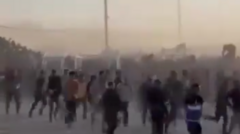In a landmark trial, Dmitriy Kurashov, a Russian soldier, stands accused of executing a Ukrainian captive on the battlefield, marking a significant development in Ukraine's efforts to address war crimes. The court proceedings reveal harrowing details surrounding the alleged incident amidst the ongoing conflict.
First Trial of a Russian Soldier in Ukraine for Alleged Battlefield Execution

First Trial of a Russian Soldier in Ukraine for Alleged Battlefield Execution
Russian soldier Dmitriy Kurashov faces unprecedented war crimes trial over execution of Ukrainian captive.
In Zaporizhzhia, a historical trial featuring a Russian soldier began, aiming to bring accountability to alleged war crimes during the Ukraine conflict. Dmitriy Kurashov, known as "Stalker," is accused of executing Ukrainian soldier Vitalii Hodniuk, in a case that has garnered significant attention for its unique nature in the war's context.
The battlefield on the eastern front portrayed a harsh reality where a small cluster of abandoned foxholes bore witness to the devastating consequences of war. Just weeks before Kurashov's trial commenced, Ukrainian forces had reported a series of battle confrontations in which numerous lives were lost on both sides. Among the fallen was Hodniuk, known by his callsign "Penguin," who was allegedly killed while attempting to surrender.
Kurashov's trial marks a crucial step in the pursuit of justice, as he is the first to face legal proceedings for an alleged execution amidst a backdrop of widespread war crimes committed since the onset of the conflict. Ukrainian officials assert that a minimum of 124 instances of executions have been recorded on the battlefield, underlining the need for accountability. Notably, Kurashov's case stands out as it includes testimonies from three members of his own unit, who corroborated the prosecution’s claims.
During the trial, evidence was presented including testimonies of the chaotic events during the assault that led to Hodniuk's death. Witnesses recounted Hodniuk's surrender and Kurashov's alleged actions that breached the laws of war. While initial pleas of not guilty were soon revised to guilty, Kurashov maintained that he only switched his plea to expedite the trial process, asserting innocence.
The investigation into the war crimes has extensively relied on witness testimonies rather than forensic evidence due to the challenges of accessing the battlefield. The prosecution team has meticulously gathered over 2,000 pages of evidence to support their case, emphasizing the seriousness of the charges against Kurashov.
Ukrainian authorities have adopted a systematic approach in prosecuting war crimes, emphasizing the need for accountability while grappling with the complexities of evidence gathering in active conflict zones. As the trial unfolds, a broader goal emerges for Ukraine: tackling higher-level command structures responsible for orchestrating or permitting war crimes.
The trial of Dmitriy Kurashov serves as a grim reminder of the human cost of war and the pressing need for nations to uphold international humanitarian law. As the court grapples with issues of credibility and the precarious nature of witness testimony, it remains crucial to ascertain accountability amidst the fog of war. With the world watching, the outcome of anticipated legal proceedings will likely influence future efforts to seek justice for victims of conflict.
As the trial continues, there is hope that it may redefine accountability mechanisms in wartime scenarios, shedding light on the pressing issue of war crimes in modern conflicts.
The battlefield on the eastern front portrayed a harsh reality where a small cluster of abandoned foxholes bore witness to the devastating consequences of war. Just weeks before Kurashov's trial commenced, Ukrainian forces had reported a series of battle confrontations in which numerous lives were lost on both sides. Among the fallen was Hodniuk, known by his callsign "Penguin," who was allegedly killed while attempting to surrender.
Kurashov's trial marks a crucial step in the pursuit of justice, as he is the first to face legal proceedings for an alleged execution amidst a backdrop of widespread war crimes committed since the onset of the conflict. Ukrainian officials assert that a minimum of 124 instances of executions have been recorded on the battlefield, underlining the need for accountability. Notably, Kurashov's case stands out as it includes testimonies from three members of his own unit, who corroborated the prosecution’s claims.
During the trial, evidence was presented including testimonies of the chaotic events during the assault that led to Hodniuk's death. Witnesses recounted Hodniuk's surrender and Kurashov's alleged actions that breached the laws of war. While initial pleas of not guilty were soon revised to guilty, Kurashov maintained that he only switched his plea to expedite the trial process, asserting innocence.
The investigation into the war crimes has extensively relied on witness testimonies rather than forensic evidence due to the challenges of accessing the battlefield. The prosecution team has meticulously gathered over 2,000 pages of evidence to support their case, emphasizing the seriousness of the charges against Kurashov.
Ukrainian authorities have adopted a systematic approach in prosecuting war crimes, emphasizing the need for accountability while grappling with the complexities of evidence gathering in active conflict zones. As the trial unfolds, a broader goal emerges for Ukraine: tackling higher-level command structures responsible for orchestrating or permitting war crimes.
The trial of Dmitriy Kurashov serves as a grim reminder of the human cost of war and the pressing need for nations to uphold international humanitarian law. As the court grapples with issues of credibility and the precarious nature of witness testimony, it remains crucial to ascertain accountability amidst the fog of war. With the world watching, the outcome of anticipated legal proceedings will likely influence future efforts to seek justice for victims of conflict.
As the trial continues, there is hope that it may redefine accountability mechanisms in wartime scenarios, shedding light on the pressing issue of war crimes in modern conflicts.

















